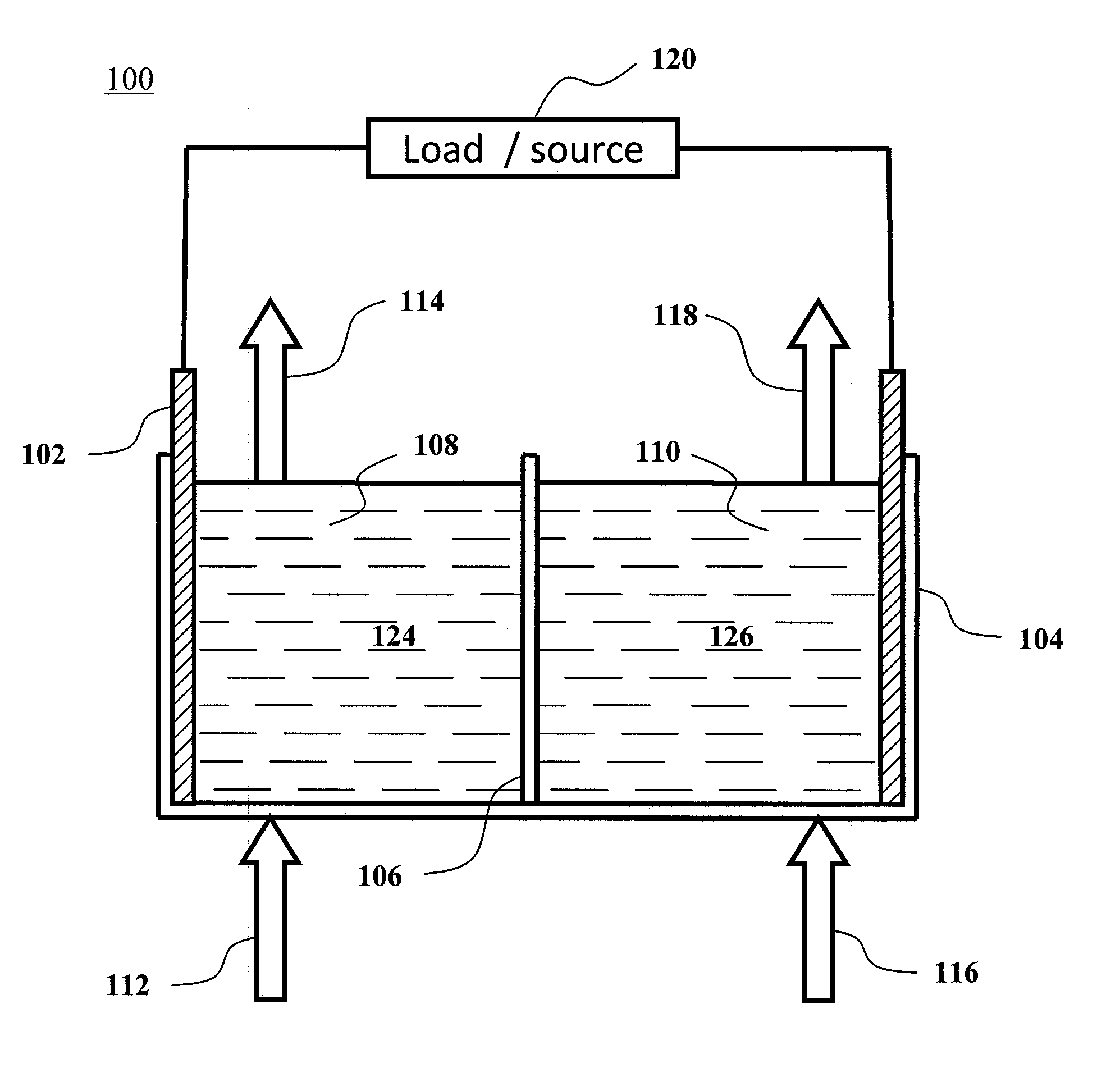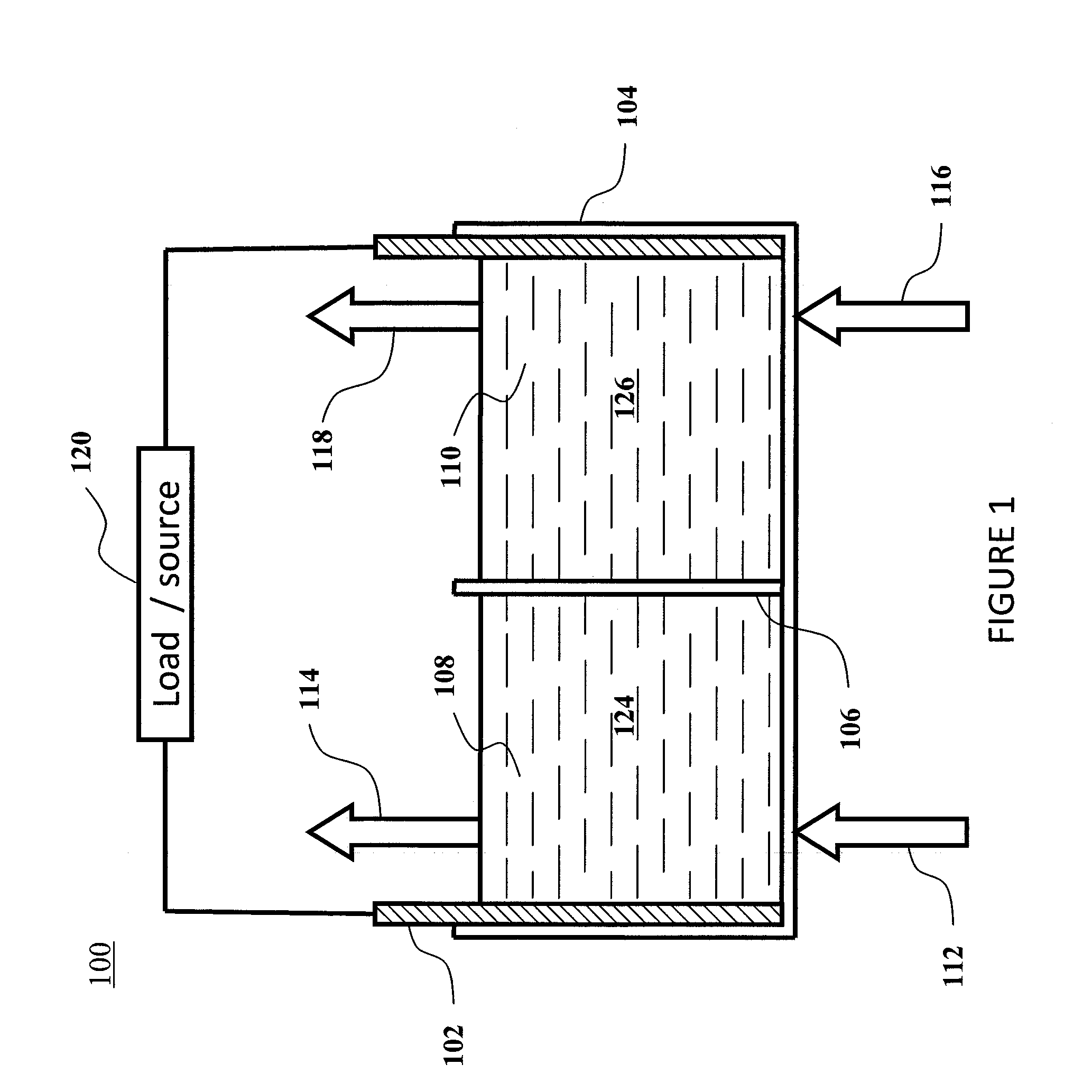Methods for the preparation of electrolytes for chromium-iron redox flow batteries
a technology of redox flow batteries and electrolytes, which is applied in the direction of electrical equipment, basic electric elements, fuel cells, etc., can solve the problems of adversely affecting the coulombic efficiency of the battery, and the materials are typically too expensive for commercial use of redox batteries
- Summary
- Abstract
- Description
- Claims
- Application Information
AI Technical Summary
Benefits of technology
Problems solved by technology
Method used
Image
Examples
example 1
[0066]Into a solution (50 mL) of Na2Cr2O7 (0.025 M) in H2SO4 (4 M) two carbon felt electrodes with active area 3×2 cm2 and separated by 2 cm were immersed in the solution. Using a power supply, a voltage of 3.4 V to 5.5 V was applied over a period of 4 hr, during which time the current dropped from 512 mA to 109 mA. Aliquots were taken at different time intervals and the concentrations of Cr3+ and Cr6+ were measured using UV-VIS spectrophotometry by measuring the absorbance at 586 nm and 349 nm, respectively. The electrodes were removed, iron powder (0.1 g, 1.79 mmol) was added, and the mixture stirred to dissolve the iron. After filtration, the concentrations of Cr3+ and Fe2+ were measured by UV-VIS spectrophotometry to be 0.062 M and 0.063 M, respectively, and the acid concentration by pH titration to be approximately 4.2 M. The concentrations of Co, Ni and Cu were determined by ICPMS to be 0.046 ppm, 0.0015 ppm and 0.0007 ppm, respectively.
example 2
[0067]Into a solution (50 mL) of Na2Cr2O7 (0.025 M) in HCl (4 M) two carbon felt electrodes with active area 4×2.5 cm2 and separated by 2 cm were immersed in the solution. Using a power supply, a voltage of 2.5 V to 4.2 V was applied over a period of 4 hr, during which time the current dropped from 515 mA to 22 mA. Aliquots were taken at different time intervals and the concentrations of Cr3+ and Cr6+ were measured using UV-VIS spectrophotometry by measuring the absorbance at 587 nm and 346 nm, respectively. The electrodes were removed, iron powder (0.047 g, 0.84 mmol) was added, and the mixture stirred to dissolve the iron. After filtration, the concentrations of Cr3+ and Fe2+ were measured by UV-VIS spectrophotometry to be 0.049 M and 0.046 M, respectively, and the acid concentration by pH titration to be approximately 3.8 M. The concentrations of Co, Ni and Cu were determined by ICPMS to be 0.017 ppm, 1.3 ppm and 0.047 ppm, respectively.
example 3
[0068]Into a solution (50 mL) of CrO3 (0.05 M) in HCl (4 M) two carbon felt electrodes were immersed (active area 3×3 cm2 separated by 2 cm. Using a power supply, a voltage of 3.9 V to 4.3 V was applied over a period of 2.45 hr, during which time the current dropped from 519 mA to 34 mA. Aliquots were taken at different time intervals and the concentrations of Cr3+ and Cr6+ were measured using UV-VIS spectrophotometry by measuring the absorbance at 580 nm and 340 nm, respectively. The electrodes were removed, iron powder (0.093 g, 1.68 mmol) was added, and the mixture stirred to dissolve the iron. After filtration, the concentrations of Cr3+ and Fe2+ were measured by UV-VIS spectrophotometry to be 0.06 M and 0.09 M, respectively, and the acid concentration by pH titration to be approximately 0.27 M. The concentrations of Co, Ni and Cu were determined by ICPMS to be 0.021 ppm, 0.00076 ppm and 0.00032 ppm, respectively.
B. Chemical Reduction with Inorganic Reducing Agents
PUM
 Login to View More
Login to View More Abstract
Description
Claims
Application Information
 Login to View More
Login to View More - R&D
- Intellectual Property
- Life Sciences
- Materials
- Tech Scout
- Unparalleled Data Quality
- Higher Quality Content
- 60% Fewer Hallucinations
Browse by: Latest US Patents, China's latest patents, Technical Efficacy Thesaurus, Application Domain, Technology Topic, Popular Technical Reports.
© 2025 PatSnap. All rights reserved.Legal|Privacy policy|Modern Slavery Act Transparency Statement|Sitemap|About US| Contact US: help@patsnap.com



